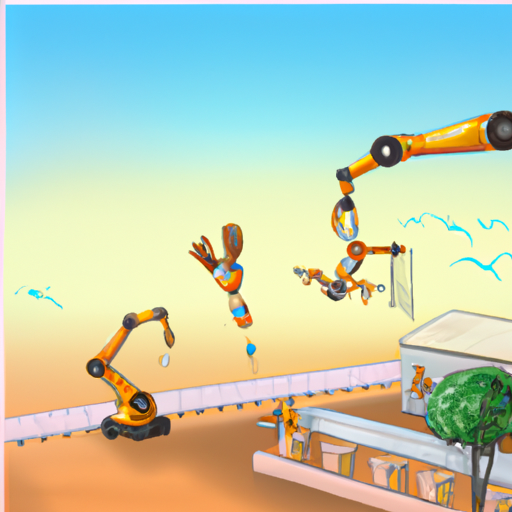-
Table of Contents
How Robotics and Automation are Changing the Job Market and Workforce
Robotics and automation are transforming the job market and workforce in unprecedented ways. As technology advances, more and more jobs are being replaced by robots and automated systems. This shift is having a profound impact on the way people work and the types of jobs available.
Robots and automated systems are becoming increasingly sophisticated and capable of performing a wide range of tasks. This means that many jobs that were once done by humans are now being done by machines. This includes jobs in manufacturing, transportation, and even some service industries. As robots and automated systems become more advanced, they are able to take on more complex tasks, such as customer service and data analysis.
The impact of robotics and automation on the job market and workforce is far-reaching. For one, it is reducing the need for human labor in many industries. This means that fewer people are needed to do the same amount of work, resulting in fewer jobs and lower wages. Additionally, robots and automated systems are often more efficient than humans, meaning that companies can produce more with fewer resources.
At the same time, robotics and automation are also creating new job opportunities. As robots and automated systems become more advanced, they require skilled technicians to maintain and repair them. Additionally, new jobs are being created in the fields of artificial intelligence and machine learning, as companies look to develop more sophisticated robots and automated systems.
Overall, robotics and automation are having a major impact on the job market and workforce. While they are reducing the need for human labor in some industries, they are also creating new job opportunities in others. As technology continues to advance, it is likely that the job market and workforce will continue to evolve in response.
The Pros and Cons of Automation and Robotics in the Workplace
Automation and robotics are becoming increasingly prevalent in the workplace, and while they can offer many advantages, they also come with some drawbacks. This article will explore the pros and cons of automation and robotics in the workplace.
Pros
One of the primary advantages of automation and robotics in the workplace is increased efficiency. Automation and robotics can help to streamline processes, reduce errors, and increase productivity. This can lead to cost savings for businesses, as well as improved customer service. Automation and robotics can also help to reduce the need for manual labor, which can help to reduce labor costs.
Another benefit of automation and robotics is improved safety. Automated systems can help to reduce the risk of accidents and injuries in the workplace, as well as reduce the need for hazardous materials. Automation and robotics can also help to reduce the risk of human error, which can lead to improved quality control.
Finally, automation and robotics can help to reduce the need for human labor, which can help to reduce labor costs. This can help businesses to remain competitive in a global market.
Cons
One of the primary drawbacks of automation and robotics in the workplace is the potential for job loss. Automation and robotics can replace human labor, which can lead to job losses. This can have a negative impact on the economy, as well as on individuals who may be displaced from their jobs.
Another potential downside of automation and robotics is the potential for increased inequality. Automation and robotics can lead to increased inequality, as those with higher levels of education and skills may be more likely to benefit from automation and robotics than those with lower levels of education and skills.
Finally, automation and robotics can lead to increased surveillance in the workplace. Automated systems can be used to monitor employee behavior, which can lead to a decrease in privacy and autonomy.
In conclusion, automation and robotics can offer many advantages in the workplace, such as increased efficiency, improved safety, and reduced labor costs. However, they also come with some drawbacks, such as job loss, increased inequality, and decreased privacy. It is important for businesses to weigh the pros and cons of automation and robotics before implementing them in the workplace.
The Impact of Robotics and Automation on Job Security
Robotics and automation have become increasingly prevalent in the modern workplace, and their impact on job security is a topic of much debate. On one hand, automation can reduce the need for human labor, leading to job losses and a decrease in job security. On the other hand, automation can also create new jobs and increase job security by allowing workers to focus on more complex tasks.
The introduction of robotics and automation into the workplace can lead to job losses in certain sectors. Automation can reduce the need for manual labor, leading to fewer jobs in manufacturing, transportation, and other labor-intensive industries. Automation can also reduce the need for certain administrative and clerical positions, such as data entry and customer service. In addition, automation can lead to job losses in certain professions, such as accounting and legal services, as software and algorithms can now perform many of the tasks that were once done by humans.
However, robotics and automation can also create new jobs and increase job security in certain sectors. Automation can free up workers to focus on more complex tasks, such as problem-solving and decision-making. This can lead to an increase in demand for workers with higher-level skills, such as software engineers and data scientists. In addition, automation can reduce the need for manual labor, leading to an increase in demand for workers with technical skills, such as robotics engineers and automation technicians.
Overall, the impact of robotics and automation on job security is complex and depends on the sector in which it is implemented. While automation can lead to job losses in certain sectors, it can also create new jobs and increase job security in others. As such, it is important for businesses to consider the potential impact of automation on their workforce before implementing it.
How Robotics and Automation are Redefining the Skills Needed in the Workforce
The advent of robotics and automation has had a profound impact on the skills needed in the workforce. As technology continues to evolve, the skills required to succeed in the modern workplace are changing.
Robotics and automation are transforming the way work is done. Automation is allowing machines to take on more complex tasks, such as data analysis and customer service. This shift is creating a need for workers with a different set of skills.
Robotics and automation are also changing the way people interact with machines. As robots become more sophisticated, they are able to interact with humans in more natural ways. This requires workers to have a better understanding of how to interact with machines and how to use them effectively.
In addition, robotics and automation are creating a need for workers with a greater understanding of technology. As machines become more complex, workers need to be able to understand how they work and how to troubleshoot any issues that may arise.
Finally, robotics and automation are creating a need for workers with a greater understanding of data. As machines become more sophisticated, they are able to collect and analyze large amounts of data. This requires workers to have a better understanding of how to interpret and use this data to make decisions.
Overall, robotics and automation are redefining the skills needed in the workforce. As technology continues to evolve, workers must be prepared to adapt to the changing landscape. Those who are able to stay ahead of the curve will be well-positioned to succeed in the modern workplace.



